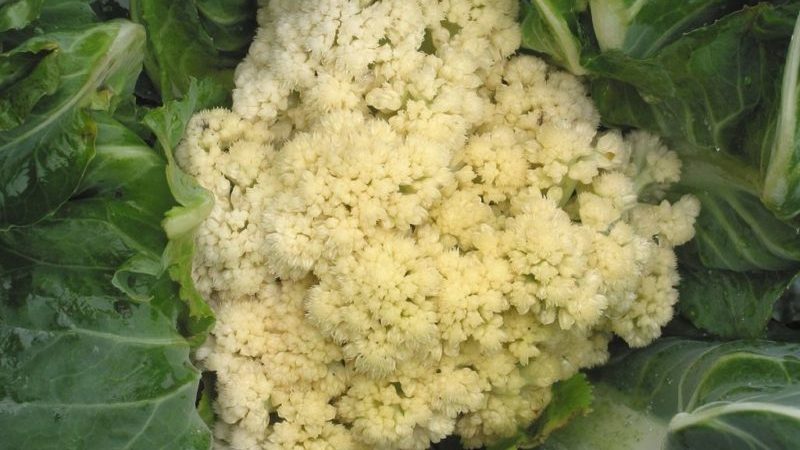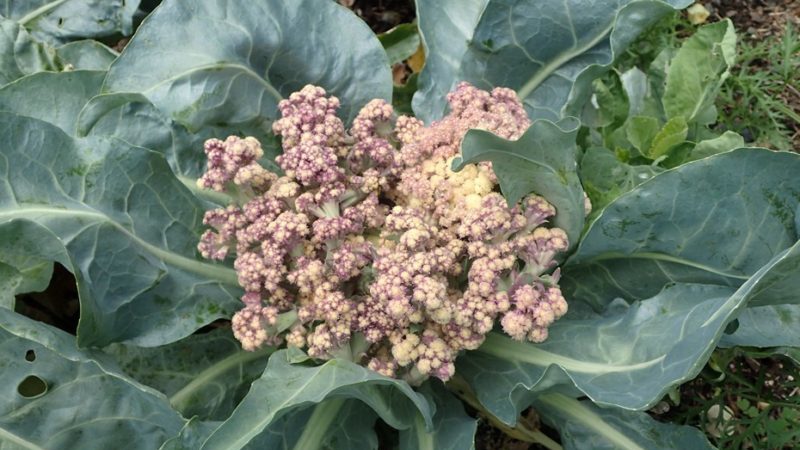Cauliflower does not tie in the open field: why it happens and what to do
Cauliflower does not form the usual heads of cabbage, but inflorescences, which are used for food. Although this crop has been known for a long time, gardeners often face various problems when growing it, the most common of which is the lack of ovaries. Let us consider in detail the reasons why cauliflower is not tied, and we will analyze the main mistakes when growing a vegetable.
The content of the article
Why cauliflower is not tied and what to do with it
Cauliflower is a demanding crop. There are many reasons why inflorescences are formed incorrectly or not at all. This is often due to mistakes that gardeners make when growing a vegetable.

Bad seeds
Poor-quality planting material is one of the reasons for obtaining plants that are too weak for fruiting or initially sterile, therefore, when buying seeds, it is important to take into account a number of nuances.
The selected variety or hybrid must be regionalized in a specific region. Often, unscrupulous producers grow crops in the southern regions in order to collect the maximum number of seeds, and then sell them in regions whose conditions are not suitable for cultivating certain varieties.
When buying seeds, be sure to pay attention to the ripening time of the variety (the time of planting the cabbage, the conditions for its cultivation and the requirements for care depend on this) and the recommended method of cultivation. Plants suitable for outdoor cultivation may not be suitable for greenhouse planting, and vice versa.
A few more recommendations for the selection and preparation of seeds:
- give preference to varieties of domestic selection;
- check the expiration date of the planting material indicated on the package;
- make a choice in favor of products of agricultural firms with a good reputation and varieties included in the State Register of Russia;
- do not harvest seeds of hybrids - they do not inherit parental traits.
If the seeds are collected from mother plants that are cross-pollinated with other cruciferous plants, the plants grown from them often do not set forks.
It is interesting:
How to store cauliflower properly
If cauliflower has bloomed, what to do with it and can you eat it
Is it possible to introduce cauliflower into the diet while breastfeeding
Improper care

Fulfillment of all agrotechnical requirements of the culture is an important condition for the formation of full-fledged inflorescences.
Landing dates
Seeds of early-maturing varieties are sown for seedlings in the first decade of March, mid- and late-maturing ones - after March 20.
Containers with crops are kept at a temperature of + 20 ... + 25 ° C, after the emergence of seedlings it is reduced to + 10 ° C for a week, then, up to transplanting seedlings into open ground, they are maintained at + 20 ° C.
Seedlings of early varieties are transplanted into the beds in early May, late ones - in the last decade of May. In this case, the average daily air temperature should be at least + 18 ° C. If during transplantation it is below + 15 ° C, after 4 weeks the cabbage will go into the arrows with seeds, and the inflorescences will not be tied.
Watering and feeding
This is a moisture-loving plant, therefore, insufficient watering often causes the absence of head ovaries. At the same time, excessive moisture and waterlogging of the soil lead to decay, death of roots and leaves and the development of bacteriosis.
Reference. In case of sufficient rainfall, cauliflower is watered weekly, during dry periods - 2-3 times a week, using 10 liters of water per 1 m².
To increase the humidity of the air, the plantings are sprayed several times a week, and the soil is mulched with chopped straw or mown and dried grass.
With a lack of nitrogen in the soil, the growth of cauliflower, especially early varieties, slows down, the upper leaves become pale, and the lower ones acquire a red or blue tint. An excess of this substance provokes increased leaf growth, due to which inflorescences are not formed, the apical growth point dies off, as a result, fruiting begins later or does not occur.
Lack of phosphorus causes the cessation of culture growth and the absence of inflorescence ovaries. In acidic soil, phosphorus is not fully assimilated, therefore, lime or dolomite flour is added to the soil before it is introduced.
With a deficiency of potassium, the plants weaken, turn yellow, and spots similar to burns appear on them. With a lack of magnesium, cabbage, starting from the top, becomes a light marble hue, over time, the leaves die off, and the plant dies. The lack of boron and molybdenum excludes the formation of inflorescences.
Recommended fertilization scheme:
- during digging of the site - 5 kg of fresh manure (in autumn) or 5 kg of humus (in spring) per 1 m²;
- 2 weeks after transplanting seedlings into the ground - a solution of mineral fertilizers (2 g of superphosphate, ammonium nitrate and potassium chloride per 1 liter of water);
- after 12-14 days - repeated watering with a solution of mineral fertilizers;
- when forming heads - watering with a solution of boron and molybdenum (2.5 g of substances per 10 liters of water) at the rate of 1 liter for each plant.
If the soil is too depleted, the feeding rate is increased by a quarter.
Diseases and pests

Diseases and pests dangerous for cauliflower are described in the table.
| Disease / pest | Signs | Treatment / prevention |
| Mucous bacteriosis | Putrid spots appear on the heads of cabbage. | At the initial stage of the disease, with a slight lesion, the rot is cut off with a sharp knife. If she has hit most of the vegetable, it is plucked from the garden and burned. |
| Blackleg | The disease affects seedlings, the base of the stems darkens, softens, the plant dies. | Affected specimens are immediately destroyed. For prevention, seedlings are treated with Previkur 607 SL. |
| Alternaria | The leaves darken, concentric circles appear on them. | For prophylaxis, seeds are treated with Planriz or Tiram preparations. During the growing season, plants are sprayed with Bordeaux liquid or copper sulfate. |
| Keela | The fungus infects the cauliflower roots, growths form on them, the root system rots, and the plant dies. | For prophylaxis, ash is introduced into the soil, at the end of the season the soil is sprinkled with dolomite flour. |
| Downy mildew | A white bloom appears on the leaves, they gradually die off. | Affected plant areas are removed to prevent the spread of disease. Landings are sprayed with Bordeaux liquid or "Polycarbacin". |
| Cabbage fly | Pest larvae and eggs are visible near the stems. | The larvae and eggs are immediately removed, the cabbage is spud. The procedure is repeated several times. The soil around the plants is sprinkled with an ash-tobacco mixture. |
| Cruciferous flea | Small beetles damage all parts of plants. The larvae develop on the roots. | For the prevention and control of insects, weeds are regularly removed and the soil is treated with lime or ash. |
| Cabbage white | Insect eggs are visible on the underside of the leaves. The yellowish green larvae (caterpillars) eat holes in the cabbage. | The eggs are harvested by hand, the plants are treated with Bitoxibacillin or Lepidocid. |
Why cauliflower has inflorescences
If the cauliflower does not form dense heads, but spreading bouquets of inflorescences, it means that the fertilization regime is violated or the plants do not have enough micronutrients.
To avoid such a problem and get a good yield of cauliflower, it is important to plant the crop in a nutritious soil enriched with mineral and organic fertilizers and timely apply fertilizers containing nitrogen, phosphorus, potassium, magnesium, boron and molybdenum.
Read also:
The best Dutch varieties and hybrids of white cabbage
The best varieties of cabbage for pickling and storing for the winter
Conclusion
Every gardener can get a good harvest of cauliflower if you make some effort for this and fulfill all the agrotechnical requirements of the crop. First of all, it is important to choose the right seeds and determine the timing of their sowing, and then follow the recommendations for caring for plantings: watering in a timely manner, fertilizing and not neglecting the preventive treatment of plants from diseases and pests.